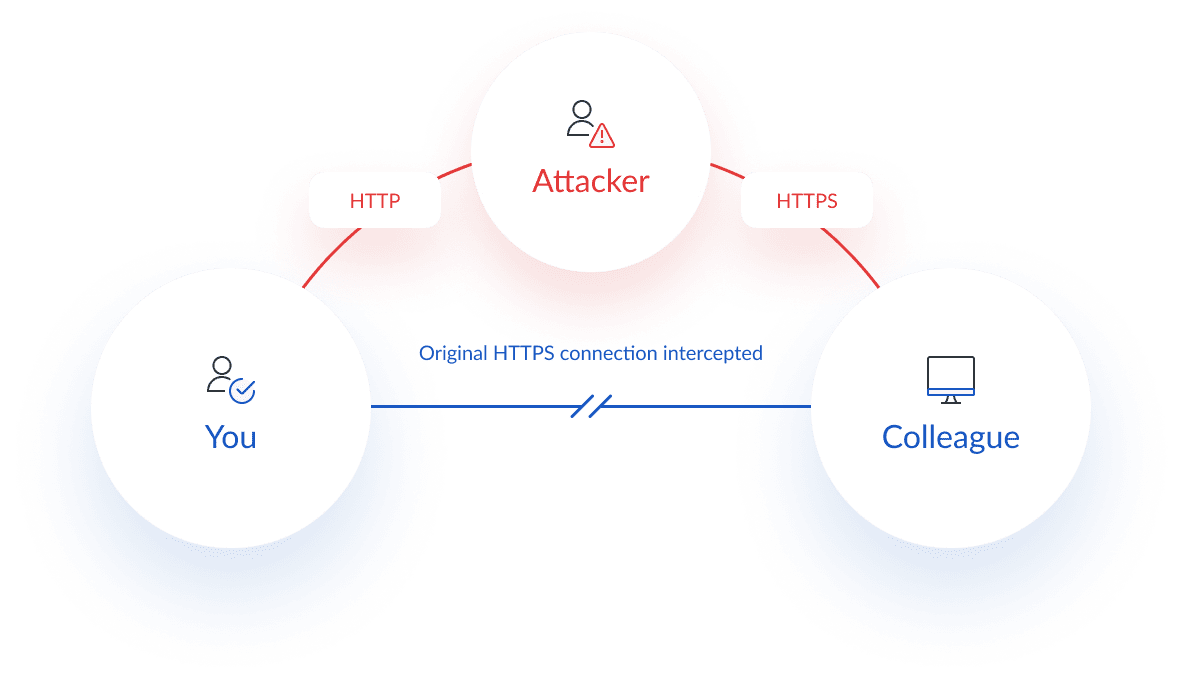What are Man-in-the-Middle (MITM) Attacks?
Man-in-the-Middle (MITM) attacks are one of the most common and dangerous cybersecurity threats. These attacks occur when cybercriminals position themselves between two parties communicating online (e.g., you and a website) to intercept, monitor, or manipulate the data being transmitted—without either party realizing the attack.
MITM attacks exploit vulnerabilities in networks, email accounts, web browsers, and even user behavior. The consequences? Stolen sensitive data like login credentials, financial information, and altered communications that benefit the attacker.
If you’ve ever wondered whether your online communications are truly private, it’s time to take a closer look at MITM attacks—and more importantly, learn how to safeguard yourself.
How Man-in-the-Middle Attacks Work
Step 1: Interception
The first step in a MITM attack is intercepting data traveling between two parties. Hackers may exploit unsecured networks, rogue Wi-Fi hotspots (like “Evil Twins”), or phishing links to insert themselves into the communication channel without either party noticing.
Examples include:
- Public Wi-Fi Eavesdropping – Hackers target unsecured public networks like those in cafes or airports to intercept communications and data packets.
- Phishing and Malware – A fraudulent email with malicious links may download malware onto a user’s device, giving attackers access to the data being transmitted.
Step 2: Decryption
Once attackers intercept the communication, they decrypt the data to extract sensitive information. While encryption protocols like SSL/TLS protect most modern communications, cybercriminals may still steal encryption keys, spoof IP addresses, or employ brute force attacks to bypass safeguards.
Common Man-in-the-Middle Attack Techniques
- Wi-Fi Eavesdropping
By setting up rogue Wi-Fi networks that mimic legitimate ones, attackers can trick unsuspecting users into connecting to their fake access points. Once connected, hackers intercept sensitive communication, stealing login credentials or credit card numbers via packet sniffing tools like Wireshark. - DNS Spoofing
The Domain Name System (DNS) functions like an internet phonebook, mapping domain names to IP addresses. Attackers tamper with DNS entries to redirect users to fake, lookalike websites designed to steal user credentials or personal data. - Session Hijacking
Attackers steal session cookies—the small data files used to verify a user’s identity during active logins—to impersonate users on secure websites like online banking or email platforms. This exploitation, often called “side-jacking,” allows attackers to take over active sessions without needing login credentials. - Man-in-the-Browser
This involves browser-based malware that covertly alters transactions or captures sensitive information without raising suspicion. For instance, malware might modify the details of a bank transfer while presenting legitimate information to the user.
How to Protect Yourself from MITM Attacks
1. Use HTTPS Websites
Always ensure the websites you visit display a padlock icon and “HTTPS” in the address bar. HTTPS connections encrypt your communication, making it harder for attackers to intercept or decrypt data. Avoid HTTP-only websites entirely.
2. Secure Your Wi-Fi
- Avoid using public Wi-Fi networks for sensitive activities like banking or shopping.
- Use a Virtual Private Network (VPN) when accessing public networks to create a secure, encrypted tunnel for your data.
- Keep your home Wi-Fi password-protected and updated.
3. Beware of Phishing Attempts
Think twice before clicking on links in unsolicited emails or messages. Verify the sender’s identity and check the URL for misspellings, as phishing websites often mimic legitimate ones.
4. Install Browser Extensions
Use browser extensions like HTTPS Everywhere to redirect you to HTTPS versions of websites automatically.
5. Enable Multi-Factor Authentication (MFA)
MFA adds an extra security layer, ensuring attackers cannot access your accounts even if they acquire your login credentials.
6. Run Regular Software Updates
Update your operating system, browsers, and apps regularly to patch vulnerabilities that attackers could exploit.
7. Educate Yourself and Your Team
If you’re part of an organization, implement cybersecurity awareness training to educate employees about avoiding common threats like phishing, fake Wi-Fi networks, and malicious attachments.
Why MITM Attacks Are Dangerous
Man-in-the-Middle attacks are especially malicious because they exploit the systems we use every day for shopping, banking, and even personal conversations. Worse, they’re difficult to detect since everything seems normal to the user.
By learning the most common attack techniques and adopting proper safeguards, both individuals and organizations can minimize the risks significantly.
Finally
Man-in-the-Middle attacks remind us that online security demands proactive measures, from encrypting communications to avoiding risky public networks. Investing a little time into securing your online interactions can prevent significant data breaches and financial losses.





